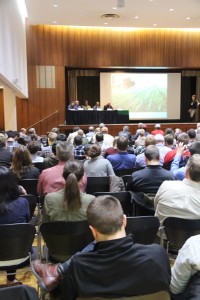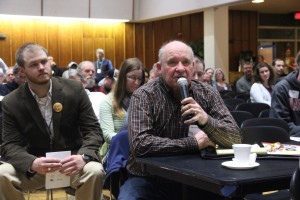
A full house for the University of Minnesota’s Production Ag Symposium.
Written by Jonathan Eisenthal
Cover crops are not always an easy fit in Minnesota farms. But more science is being done annually to help farmers see the benefit, and to find useful ways to manage cover crops to eliminate yield risks while maximizing environmental benefits.
Hundreds of graduate agriculture students and professors gathered last week at the University of Minnesota agriculture campus in St. Paul to hear about these latest scientific research findings.
“Don’t farm naked!” Sarah Carlson told the audience. “Use cover crops!”
Carlson is the Midwest cover crop research coordinator for the Practical Farmers of Iowa group. She traced the history of Iowa’s increase in soil erosion and water quality problems to the change over from small grain production to soybean production. She did not demean the soybean plant itself, but noted that both corn and soybeans are warm weather plants, while small grains like oats and winter wheat are cool weather crops, so the change to soybeans is what has led farmers to leave large tracts of uncovered soil in the spring and fall — the two seasons when the Midwest is likeliest to get hit by heavy rains that can wash away soil and nutrients.
“Cover crops are cool season plants that can address the problem with having two warm season crops dominate landscape,” Carlson said.
Paul Meints, Research Director for the Minnesota Corn Growers Association, notes that the turnout of students to this annual student organized/student run event, called the Production Ag Symposium is a great cause for optimism.
“I was pleased to see the turnout,” Meints said. “When I was on the stairs waiting to get up to the registration table, the folks in front of me were from the University of Wisconsin — River Falls and they had brought three classes of their students over for the symposium. That kind of engagement in the next generation of agriculturists is going to be key to both figuring out how we make cover crops work in the northern landscape as well as keeping agriculture engaged and moving forward with new ideas. I thought that was really encouraging.”
Meints says the day’s research presentations begin to give a scientific foundation for what many farmers suspected for a long time, or gathered through anecdotal experience: not only does cover cropping improve soil health, but, done right, it enhances the economics of farming, too.
“I was impressed with one presentation looking at nutrient cycling and how cover crops impact that,” Meints said. “Cover crops bring nutrients up into the upper area of the soil and make it available for the next crop. They were showing nitrogen and sulfur and chlorine moved up into that upper 10 centimeters of soil and retained there after a cover crop. That really makes it available for the next plant system that comes in. We’ve known that or suspected it, and we’ve talked about using cover crops for deep mining nutrients, but that was a study that was actually demonstrating it with a number of essential nutrients. That research came from Angela Florence at the University of Nebraska.”
In addition to all the academics in the room, a number of farmers and crop consultants wanting to learn more about cover crops attended the day. Larry Michaletz from Lester Prairie says “I got interested in cover crops two years ago, when I had a lot of drowned out fields that were prevented plant. I put in radishes…and they were amazing.”
Michaletz found the day valuable because he could learn from farmers like Jerry and Nancy Ackerman, Jackson County farmers who have used conservation tillage and cover crops for the past 16 years. Jerry Ackermann shared some of his experiences with the benefits of cover crops during a panel discussion. The Ackermanns use covers in all of their corn and soybean acres. They interseed in the corn when it is between the V4 to V6 stage, using a mix of 12 pounds of annual rye, two pounds of medium red clover, a pound of turnips, a pound of rapeseed, and they fly on seed to their soybean acres, planting mostly cereal rye and sometimes adding a pound of radish and a pound of rapeseed per acre.
Here are some of Jerry’s thoughts about his use of cover crops:

Taking questions from the audience at the University of Minnesota Production Ag Symposium.
“We are noticing that, after a couple of years of planting covers, all of a sudden, we are not calling the tiling machine all the time. Some of those wet spots are disappearing. And then you are finding these added benefits. For instance, this past year, my neighbor still had a few days of corn combining to go, and my combine was all washed up and two semis and a grain cart sitting there, so I called him up and I said you know I could come and help you get done, and he said, ‘Oh man, that would be great!’
“I got over there and he said, ‘It’s a wonder this crop is standing.’ I said, ‘Why’s that?’ He said, ‘Walk over here — pinch this stalk.’ I could touch my fingers together, so I said, ‘What variety is this?’ and when I found out, I said ‘I had that same variety and I didn’t have that problem at all.’
“I kept thinking about it and I realized I hadn’t had any stalk rot in any of my fields. I got a call a week or so later from someone at NRCS in Rock County and she said, ‘It’s the darnedest thing, my husband and father farm together and I talked them into using cover crops, but she said they did half the field. The problem was, the half they didn’t do was all falling down, they had to go in there and get it combined. It was all stalk rot.
“Stalk rot comes from a spore that’s in your soil. When you’ve got a living ground cover that’s green it keeps the rain from splashing up and infecting that corn plant. That’s another added benefit we have found. I really, truly believe that we are going to be using cover crops for weed control. In fact this year with the early seeding we are going to do our burn down, and if it looks clean I think we are going to seed to cover right away, because the minute you get it seeded, you don’t have a weed problem.
“One of the other added benefits is water infiltration. The wet spots are disappearing. It really hit home this fall. We were done combining and we had six inches of rain in a week. I happened to be in Lakefield and I’m driving home and I see this bean field and the end rows are a lake, and there are these big black chunks of soil that they turned up from all the traffic with the semis driving through the standing water.
“Next field I see the same thing. When I drove past one of my fields I thought that corn went 193 bushels dry, that’s a lot of acres, a lot of semi loads out of that field, but as I looked down those end rows there wasn’t a drop of water standing. So I thought, this is interesting. I drove around to all my fields, checked where the semis were parked. Out of that six inches of rain I had no water standing. So, I solved my compaction problem. I also got my water infiltration.”

